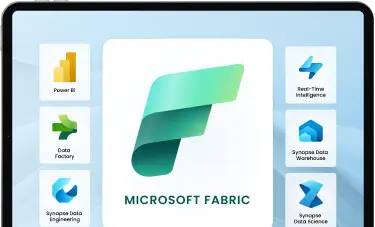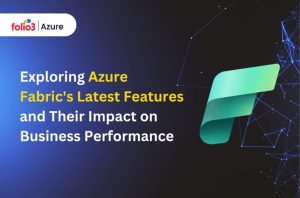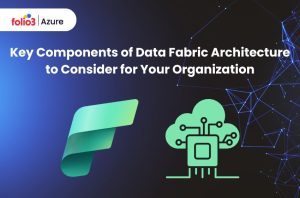Table of Contents
ToggleMicrosoft Fabric is a comprehensive solution for data analytics, providing complete data service features on a platform. Microsoft Dynamics 365 Finance is advanced financial management software that helps your business streamline financial processes worldwide. Implementing Microsoft Fabric for Dynamics 365 Finance & Operations (D365 F&O) can boost your enterprise resource planning (ERP) system’s performance.
This implementation guide will walk you through a detailed, step-by-step guide to ensure a smooth fabric implementation for MS Dynamics FNO ERP. Whether your goal is to optimize deployment strategies or simplify the connection between Microsoft Fabric and your ERP system, we have you covered. By following the steps, you can achieve the maximum potential of your ERP system and lead to better business outcomes.
Accelerate smart decisions with Microsoft Fabric's unified data and AI analytics.

Steps to Implement Microsoft Fabric for Dynamics 365 Finance & Operations
Implementing Microsoft Fabric for Dynamics 365 Finance & Operations requires several important steps. By carefully following these instructions, you can guarantee smooth integration and maximum ERP system performance.
1. Pre-Implementation Planning
Thorough planning is the key to effective implementation. This phase is important as it lays the foundation for a successful Microsoft Fabric installation. First of all, you must define your objectives, understand your current system’s capabilities, and identify the required resources. A detailed project plan should outline each step, assign responsibilities, and set timelines.
Start by determining the exact requirements of your business by performing a needs assessment. This includes evaluating your current IT setup, determining the important stakeholders, and understanding the scope of the implementation. Engage with your team to get feedback and make sure that everyone understands the objectives of the project. Risk evaluation and reduction techniques are also a part of planning in order to handle any issues that may arise during implementation.
2. Prerequisites and Preparations
Ensure you meet all prerequisites before getting into the actual installation process. These include verifying that your system meets the hardware and software requirements for both Dynamics 365 Finance and Operations setup and Microsoft Fabric.
Moreover , it’s recommended and very important to back up your existing data to prevent any loss during the installation process. Regular data backups are highly recommended for maintaining data integrity and ensuring business continuity in case of any accidental data loss.
Make sure your IT staff has the skills and expertise required to manage the configuration and installation. To familiarize people with the new system, this could include holding seminars or training sessions. Setting appropriate budgets, time, and personnel to assist the implementation process is also important. Creating a communication strategy to update all stakeholders on progress and any problems is also vital at this stage.
3. Installing Microsoft Fabric
The initial technical step in the implementation guide consists of installing Microsoft Fabric. According to Microsoft’s documentation, you should download the latest version of the software from their official site. Follow the step-by-step installation guide to ensure that Microsoft Fabric is correctly installed on your system. This process might involve setting up servers, configuring networks, and ensuring all components are correctly installed.
During installation, you must closely monitor the following of setup instructions and configuration settings. Proper installation is the key for the stability and best performance of the integrated system. If you come across any problems, you may refer to the official Microsoft documentation or get assistance from their support team. Maintaining a detailed installation log can help track the process and identify any errors that must be removed.
4. Configuring Microsoft Fabric
After the Microsoft fabric installation, the next step is to configure it. This step involves setting up different parameters that match with your organization’s requirements. You will need to configure settings for data integration, security protocols, and user access. Proper configuration is important for ensuring that Microsoft Fabric functions smoothly with Dynamics 365 Finance and Operations.
It is a good idea to create a detailed configuration documentation to record the settings and adjustments made during this phase. This documentation will be valuable for troubleshooting and future reference. Ensure that security measures are in enacted to protect sensitive data and save data from unauthorized access. Moreover, setting up user roles and permissions is important for maintaining data security and compliance with organizational policies.
5. Connecting Microsoft Fabric to Dynamics 365
Once it is installed and set up, the next step is to connecting Microsoft Fabric to Dynamics 365 Finance and Operations. This connection is the life line as it enables smooth data flow between the systems. You will need to follow particular steps to make sure that the integration is working. This involves using APIs, configuring data connectors, and verifying that data is being transferred correctly.
Thoroughly test the connection to ensure that data is being smoothly transmitted between Dynamics 365 and Microsoft Fabric. Monitor data flows and quickly resolve any discrepancies or problems. Establishing a trustworthy connection is essential for keeping your ERP data consistent and secure. Long-term success depends on regular connection maintenance and monitoring.
6. Customizing the Integration
Every business has its own needs and targets, the integration between Microsoft Fabric and Dynamics 365 Finance and Operations may require personalization to fulfill these needs. In order to customize the integration, you might have to start by setting up particular workflows, creating custom dashboards, and configuring reporting tools to meet your business requirements.
You must work closely by collaborating with your team to identify areas where customization is needed. Engage with end-users to understand their processes and requirements. Implement tailored solutions that boost the efficiency and effectiveness of your ERP system. It is a smart move to document all customizations for future reference and maintenance. Providing training and support for end-users on how to utilize these customizations effectively is also essential for performance optimization.
7. Testing the Integration
Thorough testing is highly recommended and important before fully deploying the integrated system. This guarantees that all components work together successfully and as expected. Moreover there are no issues with data integrity or system performance. Testing should cover all parts of the integration, including data transfer, user access, and overall system functionality. Any issues that are spotted during testing should be resolved before moving to deployment phase.
Create a thorough testing plan that considers various use cases and scenarios. Conduct comprehensive testing to verify the integration’s functionality. Include important stakeholders in the testing process to get feedback and ensure the system meets the expectations. User acceptance testing, or UAT, is an essential step to ensure that the system satisfies user and business requirements.
8. Deployment
After undergoing successful testing phase, you are now ready for deployment of the software. This phase involves shifting the integrated system from a testing environment to a live production environment. It’s highly recommended to follow best practices for deployment strategies to minimize downtime and ensure a smooth transition to the new system. This step may involve phased rollouts, close monitoring, and having a rollback plan in case of unexpected issues.
Plan the deployment carefully to minimize downtime and disruptions of your business activities. Share the deployment strategy and any possible impact to all stakeholders. Monitor the system closely during the deployment phase and have a proactive approach for addressing any issues that arise. Implementing a phased rollout can help manage risks and ensure a controlled deployment process.
9. Post-Deployment Activities
The last stage is not deployment. Activities carried out after deployment are important for maintaining successful system functionality and guaranteeing long-term success. These tasks include routine maintenance, training users, and monitoring the system’s functionality. Furthermore, gathering feedback from users may help in determining what additional changes or improvements are required.
Create a post-deployment support strategy to handle any problems or inquiries users might have. Hold training sessions to ensure users are at ease with the new system. Monitor the system’s performance and make any required modifications. Review and update the system often to include new features and enhancements.
Conclusion
Implementing Microsoft Fabric for Dynamics 365 Finance & Operations can boost your ERP’s functionalities and capabilities. By adhering to this step-by-step guide, you can ensure a smooth and efficient implementation process.
From pre-implementation planning to post-deployment activities, each step holds immense importance for gaining best performance and integration. If you’re ready to enhance and refine your ERP system with Microsoft Fabric, follow this guide to get started today. Remember that continuous monitoring and improvement are vital to utilizing the maximum potential of your ERP system.
For more in-depth information on boosting your data analytics capabilities, check out our Azure Data Analytics page. This highly valuable resource provides detailed information on enhancing your data strategy and using the sophisticated analytics capabilities available inside the Azure environment. By investigating these resources, you may improve your understanding of how to get the most benefits from your data and make more smart and informed business decisions.


